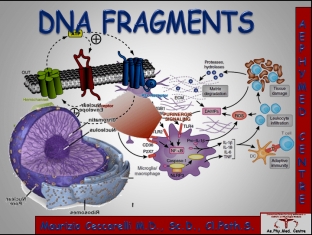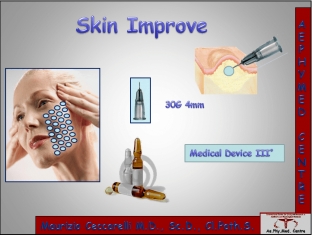Any medical intervention must comply with the Hippocratic Oath, which stated that our first task is & nbsp; - do no harm! When we hear the word "harm" in relation to our field of medicine - aesthetic, the first association that arises is & nbsp; it is the occurrence of damage caused by the use of extreme methods.
But as physicians, we must consider another possible harm – biological, that is, the change in healthy functions caused by our intervention. Consider the impact of some methods that, to give a result, they cause dermal fibrosis - biological damage leading to a change in metabolic exchanges in the skin.
Maurizio Ceccarelli - Professor, Director of the International Center for Study and Research in Aesthetic Medicine and Physiology, Scientific Referent and one of the founders of Plasma Lifting, Professor of the Department of Clinical Physiology of the Medical University of Barcelona (Spain) and Rome (Italy)
Collagen types characteristic of young and mature skin
Dermal fibrosis after retraction determines the effect of skin lifting, but this aesthetic improvement is accompanied by functional damage in the dermis. That is, in order to get an aesthetic improvement, we provoke functional damage.
Biological stimulation indicates a functional change, which can be positive or negative at the functional level. To do this, we must analyze the real consequences of everything that we understand by this term.
A term commonly used to refer to the effects of biostimulation – neocollagenesis. But this is not enough at the medical level. In fact, we need to understand what type of collagen production causes our interference with you.
We know that there are many types of collagen that are produced in the body. There are two main types of collagen in the dermis, which differ in their biochemical structure:
- fibrous collagen, or I° type, and
- collagen is reticular, reticular or type III
Fibrous type collagen is formed by one alpha-1 chain and two alpha-2 chains, while the third type of collagen reticular type consists of three alpha-1 chains.

Apart from their different structure, the two collagens present different sites in their metabolism for the primary attack of metalloproteinases. But the most important thing is that the increase in fibrous collagen, giving an aesthetic improvement, causes skin aging. An increase in type I collagen is characteristic of aging skin, while an increase in type III collagen characterizes young skin.
When a particular type of collagen is formed
The cell - the fibroblast is always the same, but according to the situation it produces different types of collagen. The reason for this fact should be sought both at the level of stimulated receptors and at the level of the environment in which procollagen is released.
When CD44 receptors are stimulated, reticular collagen is formed. CD44 is stimulated by fragments of the dermal matrix and growth factors. Stimulation of the CD39 and CD40 receptors leads to the formation of fibrous collagen. CD39 receptors are stimulated by nucleic acid fragments, and CD40 by inflammatory mediators.
Fibrous or fibrous collagen is formed to repair biological damage and is characterized by cell rupture (with release of nucleic acid) and subsequent inflammation. Thus, we can talk about two different subdivisions of fibroblasts: normal fibroblasts, which produce reticular collagen, and fibrous fibroblasts, which produce fibrous collagen.
Biostimulation: what methods are most effective
Let's analyze some of the biological and physical interventions that will actually have all the attributes of biostimulation. So, we found out that biological stimulation, giving an aesthetic improvement, can be positive or negative at the functional level.
Biostimulation with platelet growth factors is the most physiological in aesthetic medicine today. The method was born in 2001 in Spain, under the guidance of Professor Victor Garcia. PDGF acts on fibroblast tyrosine kinase (CD44) receptors, activating both multiplication and their metabolic functions. Histological studies confirm that biostimulation with platelet-derived growth factor stimulates dermal regeneration with the formation of reticular collagen, which lasts up to 9 months. Thus, the effect of biostimulation with PDGF is positive both on the functional level and on the aesthetic level.
Hyaluronic acid fragments contained in known medical preparations act, in particular, by activating CD44 receptors and fixing the results of PDGF.
Effect of hyaluronic acid on fibroblast activation
We find evidence in the scientific literature that fragments of dermal matrix components stimulate new synthesis. And, in particular, that fragments of hyaluronic acid from 20 to 38 monomers bind to CD44, activating them, while macromolecular hyaluronic acid does not cause activation of fibroblasts.
The scientific literature states that macromolecular hyaluronic acid does not activate, but blocks the synthesis of the dermal matrix. It also activates self-destruction by stimulating the activity of metalloproteinases - matrix destruction enzymes, in their catabolic action.
Thus, hyaluronic acid in its macromolecular form induces a functional block of fibroblasts and activation of the catabolic function of metalloproteinases. Serious scientific work confirms this statement.
Polish scientists conducted immunohistochemistry and compared the biological response to platelet growth factor and two biostimulants based on macromolecular hyaluronic acid.
It turned out that high molecular weight hyaluronic acid has important functions of a hydrating agent and an antioxidant. For this reason, in certain situations, we can use hyaluronic acid, not as a biostimulation, but as an alternative. For example, in patients with a negative genetic polymorphism for the hyaluronan synthetase gene, macromolecular hyaluronic acid should be administered. But in persons with genetic polymorphism for MMP (matrix metalloproteinase), which increases activity, macromolecular hyaluronic acid should not be administered at all.
Features of organic silicon in the process of biostimulation
Organic silicon activates the fibrous type of response. We find confirmation of this fact in the scientific literature: particles of organic silicon, introduced into the body, cause an inflammatory reaction with a fibrotic response, in particular:
- silanols bind to hydrophilic molecules of the dermis;
- silanols cause irritating inflammatory stimulation, which stimulates the formation of new connective tissue with collagen I ° type.
Polylactic acid activates the fibrous response
Polylactic acid is a synthetic drug, and was originally proposed only as a filler. Subsequently, marketing began to recommend it as a neocollaginesis stimulant, without specifying the type of collagen produced. The filler is metabolized, and for this reason it is considered absorbable.
However, residence time induces a fibrotic response with the formation of fibrous collagen characteristic of aging skin. The scientific literature states that polylactic acid microspheres (New-Fill or Sculptra) induce an inflammatory response. The reaction to a foreign body (filler) is different and depends on the time it has been in the body.
Neocollagenesis techniques using radiofrequency technology
Radiopurification techniques activate the formation of fibrous collagen - with aesthetic results, but with biological damage. RF frequencies cause contracture of collagen fibers from denaturation. This results in smoother skin, but with biological damage. We find confirmation of this in the literature: RF radio frequency is determined by molecular movement in tissues with heat generation. Heat causes contraction of collagen fibers and new formation of collagen in fibrous form from inflammatory damage.
Laser techniques for skin biostimulation in patients
The laser activates the fibrous type of response with aesthetic improvement, but with biological damage. When working with a laser, we denature macromolecules due to the loss of weak bonds that provide their spatial structure. Scientific works confirm our claim: the non-ablative laser induces the formation of new collagen and the modeling of scars and wrinkles. Histological studies have demonstrated the nature of the formed collagen produced by heat and generated by this method - it is fibrous.

In conclusion, we can say that all these procedures have a biological effect, but only some cause a functional improvement (recovery), while others give an aesthetic improvement (repair) with functional impairment.
Some procedures cause a functional improvement in the condition of the skin, lead to an increase in reticular collagen (type III) and a new functional matrix. At the same time, other procedures only improve the aesthetics of the face and smooth the skin, but provoke biological damage, because the newly formed tissue (fibrous collagen) slows down metabolic exchanges and disrupts skin functions.
Read also: "Regenerative technologies in practice: how to improve the condition of facial skin"
Choice of biostimulation method for different skin types
Based on the above, we should divide basal biostimulation into biostimulation for young patients and deeper biostimulation for older patients. In both cases, we use type 3 medications.
Biostimulation as a basis for young patients involves the regulation of normal physiological processes in the dermis, necessary to maintain proper biological functions with continuous regulation of anabolic and catabolic activity in the skin. That is, with the control of metalloproteinases, which destroy the components of the matrix, and fibroblasts, which restore it.
To do this, we must stimulate the activity of fibroblasts by activating CD44 receptors: We will give the activated fibroblasts amino acids for a new formation of the constituents of the dermis.
Cysteine will inhibit metalloproteinases that break down the skin matrix.
We will maintain the pH value of 7.4 in the matrix with a bicarbonate buffer, thereby preventing the process of its oxidation.
We will maintain the pH value of 7.4 in the matrix with a bicarbonate buffer, thereby preventing the process of its oxidation.
The drug is injected intradermally into the central areas of the face, neck and hands, from where it spreads throughout the skin
For older patients we do enhanced biostimulation, the so-called Skin Improve. To do this:
- Let's add antioxidants to the components of normal biostimulation to block the damage caused by free radicals, reduce the effects of chronoaging;
- add acetylcholine, which optimizes the cholinergic system of the skin.
All this provides improved corneocytic differentiation, improved microcirculation and reduced damage from photoaging. To do this, we use preparations that contain, in addition to the main composition for biostimulation, also antioxidants and choline.

The drug is injected around the perimeter of the entire face with a 30G 4 mm needle intradermally. Biostimulation is carried out after 7-15-30 days.
Read also: "Secrets liposoving"









Add a comment